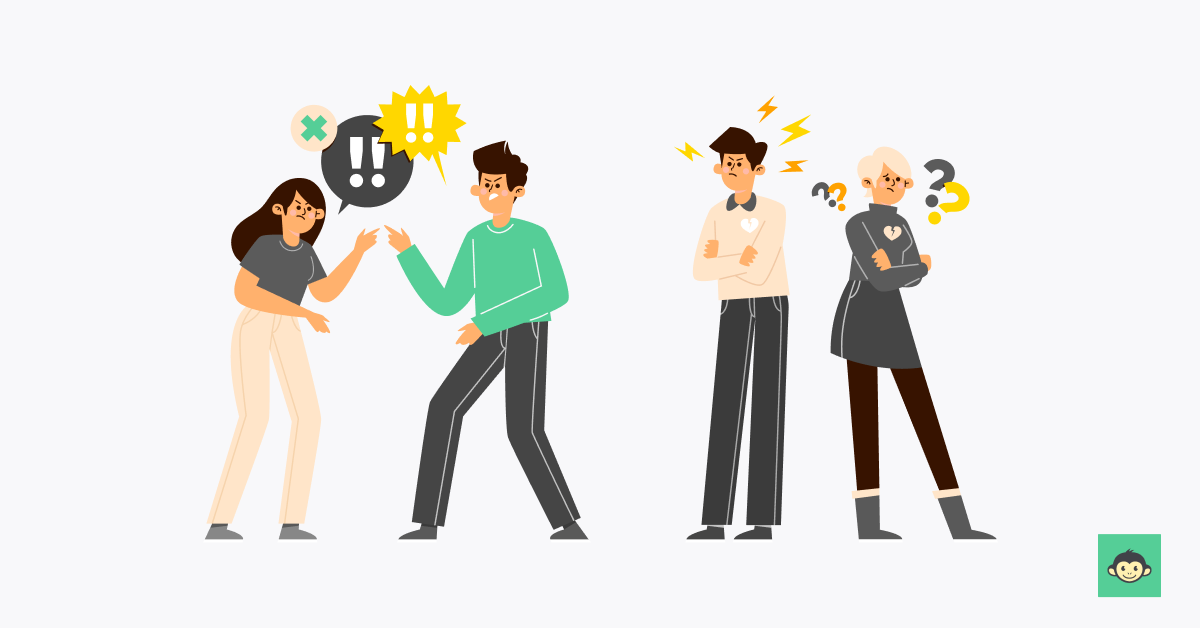Employee being passive aggressive at work: Impact and top tips to handle them

Have you ever felt a coworker's seemingly friendly smile masking a hidden agenda? Or received backhanded compliments that left you more confused than flattered?
If so, you've likely encountered the frustrating world of passive-aggressive behavior at work. While it's subtle and indirect, its impact can be significant, poisoning team power dynamics and hindering productivity.
As a leader, navigating this complex territory requires both understanding and action. This blog delves deep into the world of passive-aggressive behavior in the workplace, equipping you with the knowledge and tools to effectively deal with it.
Remember, leading a team involves navigating diverse personalities and communication styles. By understanding passive-aggressive behavior and taking proactive steps, you can create a more harmonious and productive work environment for everyone.
What is a passive aggressive work culture?

Passive aggression in the workplace can contribute to a toxic work culture, which impacts morale, productivity, and overall employee satisfaction. A passive-aggressive work culture is characterized by indirect resistance to authority, subtle undermining of colleagues, and an overall lack of accountability for one's actions.
Here's a closer look at what constitutes this kind of work culture:
- Indirect communication: Employees may avoid direct communication about issues or concerns. Instead of addressing problems openly, they may resort to subtle hints, sarcasm, or gossip, leading to misunderstandings and frustration among team members.
- Lack of accountability: Individuals who act passive aggressively often evade responsibility for their actions or mistakes. They may make excuses, blame others, or conveniently forget their commitments, which can create a culture of mistrust and resentment within the team.
- Undermining behavior: These employees may engage in behaviors that undermine their colleagues or superiors. This could include withholding of important project information, spreading rumors, or sabotaging projects behind the scenes, eroding team cohesion and hindering progress.
- Resistance to change: Employees may resist changes or new initiatives without openly expressing their concerns. Instead of offering constructive feedback or suggestions for improvement, they may subtly sabotage initiatives or drag their feet on implementation, impeding the organization's ability to adapt and thrive.
- Negative impact on morale: This kind of behavior can take a toll on employee morale and job satisfaction. Constantly navigating through indirect communication and hidden agendas can create a stressful and demoralizing work environment, leading to decreased worker engagement and higher turnover rates.
- Ineffective conflict resolution: Passive-aggressive cultures often struggle with resolving conflicts in a constructive manner. Instead of addressing issues directly and finding mutually beneficial solutions, conflicts may simmer beneath the surface or escalate into larger problems over time, further eroding trust and cooperation within the team.
- Stifled innovation and creativity: When employees feel hesitant to voice their ideas or concerns openly, innovation and creativity can suffer. A passive-aggressive work culture stifles open dialogue, conversation and collaboration, limiting the organization's ability to generate new ideas and adapt to changing market conditions.
By recognizing these signs and fostering a culture of open communication, accountability, and respect for other employees, leaders can work towards creating a healthier and more productive work environment for everyone involved.
Why is passive aggression toxic?

Passive aggression is toxic for several reasons, primarily because it undermines healthy communication, trust, and productivity in both personal and professional relationships. Here's why this behavior is considered toxic:
- Lack of transparency: It often involves indirect communication or expressing hostility through subtle actions rather than openly addressing concerns. This lack of transparency can lead to confusion, misunderstandings, and an inability to resolve issues constructively.
- Erodes trust: When someone behaves passive-aggressively, it creates an atmosphere of distrust. Colleagues or individuals may feel unsure about others' intentions or motivations, leading to a breakdown in professional relationships and collaboration.
- Undermines productivity: This kind of behavior can hinder productivity in the workplace. Instead of focusing on tasks and goals, energy may be diverted into deciphering hidden meanings or navigating interpersonal conflicts, ultimately impacting work performance and efficiency.
- Fosters resentment: Passive aggression often involves expressing negative feelings indirectly, such as through sarcasm, gossip, or subtle sabotage. This can breed resentment among colleagues or within teams, leading to a toxic work environment characterized by tension and animosity from toxic colleagues.
- Stifles problem-solving: In environments where passive aggression is prevalent, addressing and solving problems becomes challenging. Instead of openly discussing issues and working towards solutions, individuals may resort to avoidance or passive resistance, perpetuating the problem rather than resolving it.
- Negatively impacts mental health: Dealing with kind of behavior can be emotionally draining and stressful. Constantly deciphering hidden messages or navigating subtle forms of hostility can take a toll on one's mental well-being, leading to increased anxiety, frustration, and even depression over time.
- Creates a culture of unaccountability: Passive-aggressive individuals often avoid taking responsibility for their actions or mistakes, which can foster a culture of unaccountability within an organization. This lack of accountability can lead to a decline in performance standards and a diminished sense of personal and collective responsibility.
Overall, passive aggression is toxic because it undermines healthy communication, erodes trust, impedes productivity, fosters resentment, stifles problem-solving, negatively impacts mental health, and creates a culture of unaccountability.
Addressing this kind of behavior requires open dialogue, assertive communication, and a commitment to fostering a supportive and respectful environment.
Impact of passive aggressive employees at the workplace

Passive-aggressive employees can have significant negative impacts on the workplace environment, team dynamics, and overall productivity. Here are some key ways in which their behavior can affect the workplace:
- Decreased morale: Working with passive-aggressive colleagues can create a tense and uncomfortable atmosphere, leading to decreased morale among team members. Constantly dealing with indirect communication, hidden agendas, and unresolved conflicts can leave employees feeling frustrated, demotivated, and disengaged.
- Poor communication: Some forms could involve indirect communication, such as giving the silent treatment, withholding information, or using sarcasm. This lack of clear and open communication can lead to misunderstandings, misinterpretations, and breakdowns in teamwork and collaboration.
- Undermined trust: Trust is essential for effective teamwork and collaboration. However, passive-aggressive behavior erodes trust within teams and undermines professional relationships. Employees may become wary of their colleagues' intentions, leading to a breakdown in trust and cooperation.
- Increased conflict: Passive-aggressive can escalate conflicts rather than resolve them. Instead of addressing issues directly and constructively, passive-aggressive employees may engage in subtle acts of sabotage or retaliation, fueling resentment and animosity among team members.
- Reduced productivity: Dealing with passive-aggressive colleagues can be time-consuming and energy-draining. Constantly deciphering hidden messages, navigating interpersonal tensions, and addressing the fallout from unresolved conflicts can distract employees from their work and impede productivity.
- Negative impact on team dynamics: Team dynamics can be eroded and this hostile environment hinders effective collaboration. Instead of working together towards common goals, team members may become preoccupied with managing interpersonal conflicts and navigating the emotional minefield created by passive-aggressive colleagues.
- High turnover rates: Working in a toxic environment characterized by passive-aggression can take a toll on employees' well-being and job satisfaction. As a result, organizations may experience higher turnover rates as employees seek out healthier and more supportive work environments.
- Damage to organizational culture: The presence of passive-aggressive employees can undermine the organization's culture and values. A workplace culture that tolerates or enables passive-aggression sends the message that such conduct is acceptable, which can erode trust in leadership and damage the organization's reputation.
What is the root of passive-aggressive behavior?

It can stem from various underlying factors, and its root cause may differ from person to person. However, some common factors that contribute to this kind of behavior include:
- Fear of confrontation: Some individuals may resort to this behavior because they fear direct confrontation or conflict. They may avoid expressing their needs or concerns openly to avoid potential rejection, criticism, or conflict with others.
- Low self-esteem: Individuals with low self-esteem may struggle to assert themselves or communicate their feelings and needs effectively. This behavior may serve as a way to indirectly express their frustrations or assert control in situations where they feel powerless.
- Anger and resentment: Feelings of anger, resentment, or bitterness towards others or specific situations can manifest as passive-aggression. Instead of expressing their emotions directly, individuals may channel their anger into subtle acts of defiance, sabotage, or non-compliance.
- Communication style: Some people may have learned about passive aggressive co-aggression as a coping mechanism or learned behavior from their family or social environment. They may have observed passive-aggressive tactics being used to manipulate or control others and adopted similar strategies in their own interactions.
- Avoidance of responsibility: Passive-aggressive behavior can also stem from a desire to avoid taking responsibility for one's actions or decisions. By being passive-aggressive, individuals may deflect blame onto others or evade accountability for their behavior, allowing them to avoid facing consequences or uncomfortable truths.
- Control issues: Passive-aggressive behavior can be a way for individuals to assert control or exert power in situations where they feel powerless or out of control. By engaging in subtle acts of defiance or resistance, they may attempt to manipulate outcomes or assert their influence without directly confronting others.
- Underlying mental health issues: In some cases, passive-aggressive behavior may be linked to underlying mental health conditions such as depression, anxiety, or personality disorders. These conditions can affect an individual's emotional regulation, communication skills, and interpersonal relationships, leading to the manifestation of passive-aggressive behavior patterns.
It's important to recognize that passive-aggressive behavior is often a complex and multifaceted issue, and addressing it effectively may require a combination of self-reflection, communication skills development, and, in some cases, professional support or therapy.
How do you deal with a passive aggressive colleague at work as a leader: 7 Top tips to use

Dealing with a colleague exhibiting this behavior as a leader requires a strategic approach to address the behavior effectively. Here are seven top tips:
- Direct communication: Approach the colleague privately and openly discuss their behavior, focusing on specific instances rather than generalizations. Stay calm and let them know that you're on their side. In many cases, they may be unaware of their behavior and its effect on the organization.
- Set clear expectations: Clearly outline expectations for professional behavior and communication within the team, emphasizing transparency and directness.
- Provide constructive feedback: Offer constructive feedback on how this behavior impacts the team and suggest alternative approaches for addressing concerns or conflicts.
- Encourage accountability: Hold the colleague accountable for their actions and encourage them to take responsibility for their behavior and its consequences.
- Promote open dialogue: Create a culture of open dialogue and encourage team members to express their thoughts and concerns directly, fostering transparency and trust.
- Lead by example: Model assertive and respectful communication in your interactions with the team, demonstrating the importance of addressing issues directly and constructively.
- Offer support: Offer support and resources, such as conflict resolution training or coaching, to help the colleague develop healthier communication and conflict resolution skills.
Signs of a passive aggressive coworker to watch out for

Recognizing the signs of a passive-aggressive coworker is crucial for maintaining a positive work environment and addressing any issues that may arise. Here are eight key signs to watch out for:
- Indirect communication: Communication that is vague, ambiguous, or lacks clarity can be a sign of passive-aggressive behavior. This may include leaving cryptic notes, making sarcastic remarks, or using subtle words or gestures to convey dissatisfaction.
- Procrastination and delayed responses: Consistently procrastinating on tasks or delaying responses to requests. This behavior may be a way for the passive aggressive coworker to express resistance or frustration without directly addressing the issue.
- Negative attitude: A consistently negative or pessimistic attitude, especially towards authority figures or certain colleagues. This may manifest as complaining, gossiping, or making snide remarks behind others workers' backs.
- Sudden changes in behavior: Abrupt changes in behavior, such as becoming withdrawn or aloof, may indicate underlying passive-aggressive tendencies. The manager or coworker may be expressing their displeasure or resentment in subtle ways rather than addressing it directly.
- Sabotage or undermining: Passive-aggressive coworkers may engage in subtle acts of sabotage or undermining behavior to express their dissatisfaction or exert control. This could include withholding information, spreading rumors, or undermining others' efforts behind the scenes.
- Passive resistance to feedback: Resisting feedback or constructive criticism and refusing to acknowledge areas for improvement can indicate passive-aggressive tendencies. The coworker may become defensive or dismissive when confronted with feedback, hindering their own professional growth and development.
- Chronic lateness or absenteeism: Chronic lateness or absenteeism without valid reasons can be a passive-aggressive way of expressing dissatisfaction or resistance to authority. The coworker may use these behaviors as a form of rebellion or to avoid confrontational situations.
- Subtle power plays: Engaging in subtle power plays or manipulation tactics to assert control or dominance within the team is another sign of passive-aggressive behavior. This may involve withholding information, playing mind games, or subtly undermining others' authority.
By being vigilant and recognizing these signs, you can address passive-aggressive behavior early on and work towards resolving any underlying issues to foster a healthier and more productive work environment.
5 Examples of work passive aggression scenarios

- Delayed submission of work: A team member consistently submits their work just before the deadline, or missing deadlines despite having had ample time to complete it. When asked about the delay, they provide vague excuses or blame external factors, but fail to take responsibility for their procrastination.
- Ignoring emails or requests: A colleague repeatedly ignores emails or requests for information, causing delays in project timelines or hindering collaboration. When approached about the unresponsiveness, they offer minimal responses or provide incomplete information, making it difficult for others to proceed with their tasks.
- Withholding important information: A team member intentionally withholds crucial information related to a project or task, causing setbacks or confusion among team members. When questioned about the omission, they downplay its significance or feign ignorance, despite having been aware of its importance.
- Sarcastic remarks in meetings: During team meetings, a coworker makes sarcastic remarks or subtle jabs at colleagues' ideas or contributions. While they may appear to be joking, their comments undermine others' confidence and create tension within the team, making it challenging to maintain a positive and collaborative atmosphere.
- Passive-aggressive notes or messages: A coworker leaves passive-aggressive notes or messages around the office, such as criticizing the cleanliness of shared spaces or expressing dissatisfaction with certain work practices. Rather than addressing concerns directly with the relevant parties, they choose to communicate their frustrations indirectly, leading to increased tension and resentment among team members.
These specific examples demonstrate how passive-aggressive behavior can manifest in various forms in the workplace, undermining teamwork, communication, and overall productivity.
Recognizing and addressing such behavior early on is essential for fostering a healthy and supportive work environment.
Role of team collaboration surveys in identifying and removing passive aggressive culture

Team collaboration surveys play a crucial role in identifying and addressing passive-aggressive culture at work by providing valuable insights into team dynamics, communication patterns, and overall employee satisfaction.
Here's how these surveys can help companies:
- Identifying patterns of behavior: Team collaboration surveys can include questions specifically designed to uncover passive-aggressive behaviors, such as indirect communication, avoidance of responsibility, or resistance to feedback. By analyzing survey responses, leaders can identify patterns of behavior indicative of a passive-aggressive culture within the team.
- Gauging employee perceptions: Surveys allow employees to anonymously share their perceptions and experiences related to collaboration and communication within the team. This provides leaders with a comprehensive understanding of how passive-aggressive behavior is perceived by team members and its impact on morale, productivity, and job satisfaction.
- Assessing communication effectiveness: Collaboration surveys often include questions about communication effectiveness, clarity of expectations, and conflict resolution processes. These insights can help leaders assess whether passive-aggressive behavior is hindering open and transparent communication within the team and identify areas for improvement.
- Highlighting areas for intervention: Survey results can pinpoint specific areas or issues where passive-aggressive behavior is most prevalent, such as certain team interactions, projects, or communication channels. This allows leaders to prioritize interventions and develop targeted strategies for addressing passive-aggressive culture effectively.
- Promoting accountability and transparency: By conducting team collaboration surveys regularly, leaders demonstrate a commitment to fostering a culture of accountability and transparency. Employees are encouraged to voice their concerns and provide feedback anonymously, knowing that their input will be used to address issues related to passive-aggressive behavior.
- Tracking progress over time: Ongoing survey initiatives enable leaders to track progress in addressing passive-aggressive behavior and measure the effectiveness of interventions implemented. By comparing survey results over time, leaders can assess whether changes in team dynamics and communication patterns are leading to positive outcomes.
- Facilitating open dialogue: Survey results serve as a catalyst for open dialogue and discussion among team members and leaders. By sharing survey findings and insights with the team, leaders can encourage open communication about passive-aggressive behavior, its impact, and strategies for fostering a healthier work environment.
Conclusion
Recognizing and addressing indirect or hostile behavior in the workplace is crucial for maintaining a positive and productive atmosphere. Such behavior can undermine teamwork, communication, and overall morale.
If you're seeking a comprehensive and effective solution to assess and improve your workplace culture, consider partnering with CultureMonkey.
Our innovative employee engagement survey tool enables you to gather real-time feedback, track progress, and take proactive steps to cultivate a positive and inclusive work environment. Begin enhancing your workplace culture today by visiting CultureMonkey's website.



